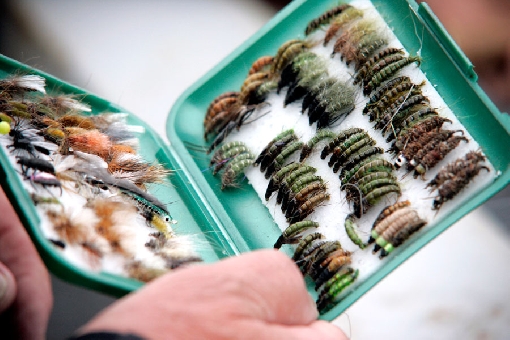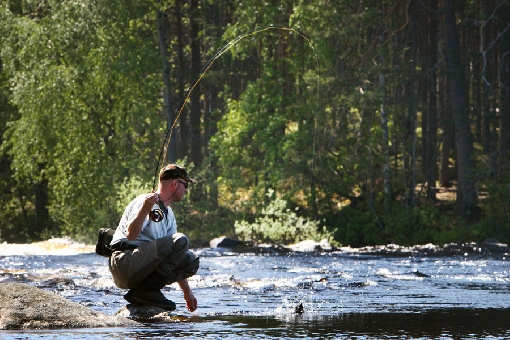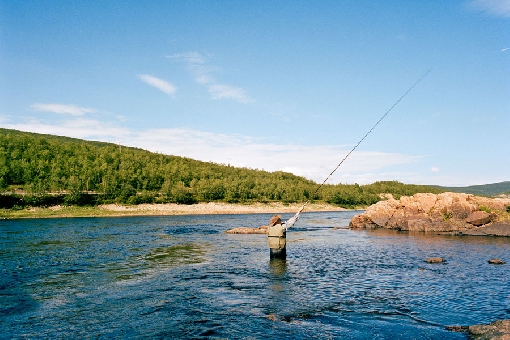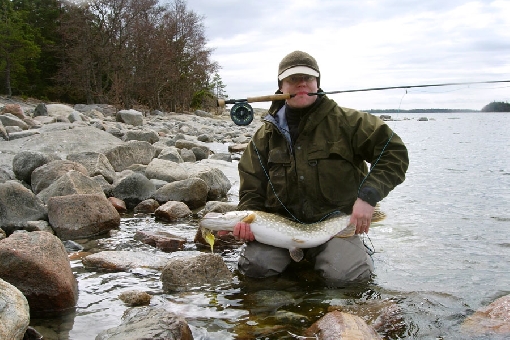Fly-fishing
Photo: Kimmo Pöri A timeless moment.
Finland's rivers and lakes are wonderful surroundings for fly-fishing enthusiasts. The abundance of species and fishing grounds provide opportunities to engage in diverse forms of fly-fishing. It's easy for fly-fishers to get to the fishing grounds.Game species on regular river sites include trout, grayling and rainbow trout, which means that Class 4–6 tackle is suitable. If you're heading to salmon rivers, you should bring Class 8–12 tackle with you. The most common fly models include imitations of the different stages of life of caddis flies and mayflies tied in natural colours. In addition, the range covers various streamers or imitation fish and leeches that imitate real leeches. Colourful flies are popular when fishing for rainbow trout. The regular hook size is 2–10. Tackle should be chosen according to the size of the river and the water level. More lightweight tackle is suitable for fishing when waters are low. Photo: Jari Salonen  You should have enough options in your fly box. Trout and rainbow trout all year round The fly-fishing season starts when the February Red stonefly swarm in April and ends for the autumn closed season in September. Fly-fishing in late autumn and winter also results in pleasant surprises on the end of the line. Grayling is the main game species in Northern Finland, occurring in almost all flowing waters and in many lakes. On the crystal clear waters of northernmost Lapland, fly-fishing enthusiasts have a unique opportunity to establish contact with wild grayling weighing as much as two kilos. Trout and rainbow trout are the most important game species in many rapid-flowing waters. Excellent sites for catching wild trout include the waters in Upper Lapland, Northwest Lapland, the Vätsäri and Kaldoaivi wilderness areas and the rapids in Kuusamo. Other popular sites include the rapids routes in Central Finland and the Ruunaa Rapids in Eastern Finland. Photo: Kimmo Pöri  The Ruunaa Rapids is one of the most popular fishing grounds in Eastern Finland. Sturdy tackle for salmon rivers Finland's salmon rivers offer fly-fishing enthusiasts splendid opportunities to wear down genuine whoppers. Both fly-casting and trolling flies on rowing boats are popular and productive forms of fishing on River Teno in particular. However, you can forget about bringing any lightweight tackle – your line may be raced by a fish weighing over 20 kilos. Whitefish is a challenging species for fly-fishing enthusiasts, but catches may be good during the peak season. In many sites, the best bite times occur early in the summer. Sizeable fish are caught in the wild waters of Lapland, but a whopper whitefish can just as easily bite in the bay near your cottage. The lakes in the Hossa area of Suomussalmi are famed for their big whitefish, as is Lake Valkeinen in Lestijärvi. Photo: Veli-Pekka Räty  On River Teno, a fly-fishing enthusiast may catch the fish of his life. Fly rods bent by pike More and more fly-fishing enthusiasts head out to the waters in pursuit of pike. It doesn't cost much to go fishing and the odds of catching some fish are good. Your fly rod may be bent by a giant pike weighing more than ten kilos. Pike are pursued in shallow waters, at the edges of rushes and shoals. Flies are easy to use in shallow waters, where other lures are difficult to fish. For pike flies, anglers use sizeable streamers and tube flies tied to large hooks. The colour scheme varies according to the time period and water colour. Even the swimming technique varies from a very peaceful pace and long stops in cold waters to a faster pace in warm waters. On the rivers of Southern Finland, it's also possible to use flies to fish for chub, asp or ide. In addition, many lakes and streams are home to big roach, which are occasionally eager to bite flies. A Finnish summer night, the foaming rapids spreading out in front of you, a smoking fire on the bank and a fly-fishing angler with a rod in his hand – that's a dream come true for many an angler. Often the moment will even be crowned with a handsome fish. That's when the angler is in the right place at the right time. Photo: Jani Ollikainen  Fly-fishing for pike has gained in popularity on the coast in particular. |